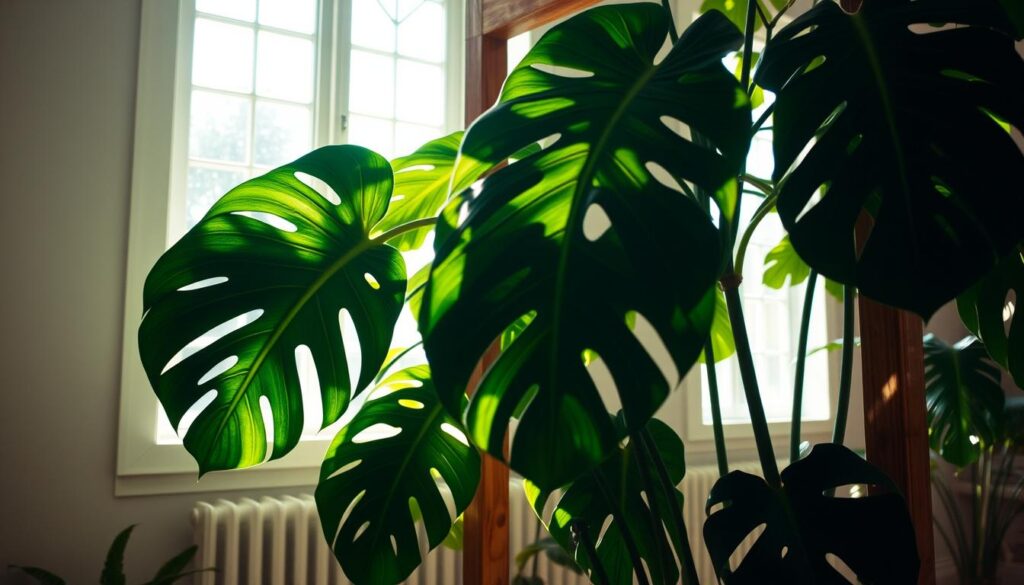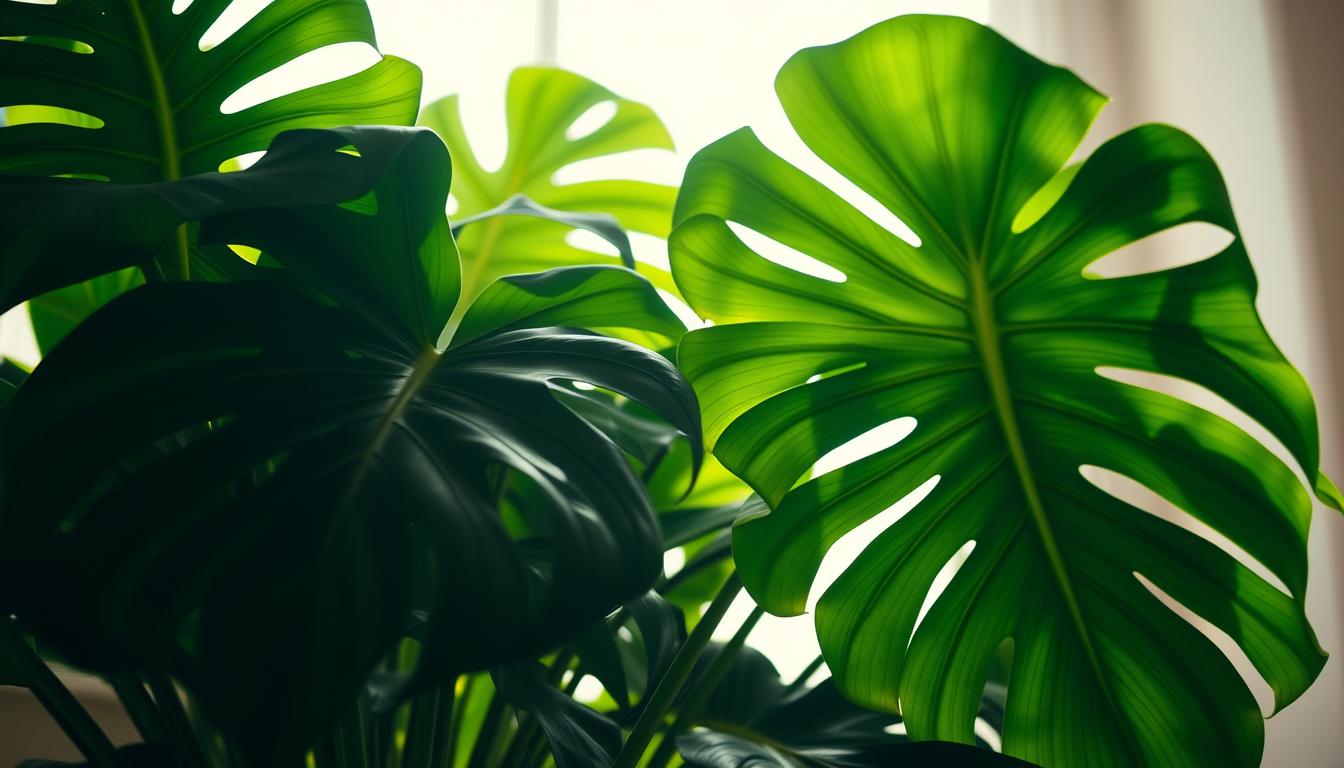What makes a Monstera deliciosa plant thrive? How can you create its natural habitat for stunning, large leaves? As you start your monstera care journey, you’ll find key tips and tricks. These will turn your space into a lush oasis. With the right care, your Monstera will reach its full beauty.
Exploring monstera care, you’ll learn about light, water, and nutrients for growth. This guide is for all plant lovers, from beginners to experts. It covers the basics of monstera care, from understanding needs to solving common problems.
Key Takeaways
- Monsteras thrive in bright, indirect sunlight, which promotes larger leaves and more fenestrations.
- Watering should be done only when the top half of the soil is completely dry to prevent overwatering.
- Temperature ranges between 65°F to 85°F are ideal for monstera deliciosa growth.
- Fertilization frequency should be every 3 to 4 times per year during the growing season.
- Repotting should occur every 1-2 years when roots grow out of drainage holes or when the plant becomes root-bound.
- Monsteras are toxic to cats and dogs, so keep them out of reach of pets and small children.
Understanding Your Monstera Deliciosa Plant
Learning about Monstera deliciosa care is key. Monsteras have big leaves with holes and splits. These features help them in their tropical home. Knowing the different Monstera types, like Monstera adansonii, is important.
It’s vital to know why Monstera leaves split. This happens as the plant grows. Understanding this helps you care for it better. The Monstera adansonii, also known as Swiss cheese plant, has similar leaves but without edge holes.
Natural Habitat and Growth Patterns
Monsteras love tropical places with high humidity and indirect light. Use a soil mix that drains well and keep humidity at 60%. They prefer temperatures between 65°F and 85°F, making them perfect for indoors.
Types of Monstera Varieties
There are many Monstera varieties, each unique. Some popular ones are:
- Monstera deliciosa
- Monstera adansonii
- Monstera obliqua
What Makes Monstera Leaves Split?
Monstera leaves split as the plant grows. This is a sign of a healthy plant. By following the right care instructions, you can help your Monstera thrive.
Understanding your Monstera deliciosa plant is crucial. By following proper care guidelines, you can enjoy its beauty. Remember, caring for your Monstera is an art that requires knowledge and patience.
| Monstera Variety | Description |
|---|---|
| Monstera deliciosa | Large, perforated leaves |
| Monstera adansonii | Hole-y leaves, referred to as Swiss cheese plant |
| Monstera obliqua | Unique, split leaves |
Perfect Light Conditions for Thriving Monstera Plants
When caring for a monstera deliciosa, light is key. These plants love bright, indirect sunlight. They do best in rooms with lots of natural light, but not right in front of windows.
Light is crucial for a Monstera’s health and growth. They need 5-8 hours of dappled or filtered light daily. Place them 3-5 ft. away from a bright, indirect light source, like a window.
- Full shade slows growth and makes leaves smaller
- Low light causes stunted growth, yellow leaves, and no new leaves
- Too much light turns leaves yellow or brown, curls them, and dries soil fast
Right light makes your Monstera grow well and look great. Put it near an East or West window for medium to bright light. Use grow lights if needed. With proper monstera deliciosa plant care and monstera care essentials, your Monstera will thrive.
Watering Your Monstera Deliciosa: The Right Approach
Watering is key when it comes to caring for your Monstera Deliciosa. Hilton Carter suggests watering only when the top half of the soil is dry. Use a porous pot to let extra moisture evaporate and prevent root rot. This method is vital to avoid root rot from too much water and leaf curl from too little.
To find the perfect watering schedule, regularly check the soil moisture. Adjust how often you water based on what you find. Here are some signs to watch for:
Signs of Overwatering
- Fungal growth
- Drooping leaves
- Soft stems
Signs of Underwatering
- Stunted growth
- Drooping
- Light brown spots on leaves
- Crispy leaf edges
- Curling leaves
- Yellow leaves
- Dry soil
By spotting these signs early, you can quickly adjust your watering. This ensures your Monstera gets the right moisture. Remember, the goal is to find a balance. With time, you’ll get better at watering your Monstera Deliciosa.
To keep your Monstera hydrated, water until the soil is fully saturated. Then, let any extra water drain out. Bottom watering is best as it helps water spread evenly and encourages roots to grow down. By following these tips, you’ll help your Monstera thrive.
| Watering Frequency | Soil Moisture | Plant Response |
|---|---|---|
| Once a week | Dry to a depth of 2-4 inches | Healthy growth, no signs of overwatering or underwatering |
| Once every 1-2 weeks | Moist but not waterlogged | Stunted growth, drooping, or yellowing leaves |
Soil and Potting Requirements for Healthy Growth
For your monstera deliciosa care instructions, the right soil and potting mix are key. A mix that drains well is crucial to avoid waterlogged soil. This can cause root rot. Using a terra-cotta pot helps with moisture evaporation, keeping your plant’s roots healthy.
A mix of peat-based media and perlite is best for monstera plant care. It ensures good drainage and aeration for healthy roots. Adding coco coir or orchid bark can also enhance the mix’s water-holding capacity and structure.
Here are some key considerations for soil and potting requirements:
- Use a well-draining potting mix to prevent waterlogged soil
- Choose a porous pot to improve moisture evaporation
- Repot your monstera every 2-4 years to refresh the soil and provide a larger pot if necessary

By following these guidelines and using the right soil and potting mix, you can help your monstera deliciosa thrive. Enjoy its beautiful, large leaves.
| Soil Ingredient | Percentage |
|---|---|
| Peat-based media | 50% |
| Perlite | 20% |
| Coco coir | 10% |
| Orchid bark | 10% |
| Worm castings | 5% |
| Activated charcoal | 5% |
Essential Monstera Deliciosa Care Tips for Maximum Growth
To make sure your Monstera deliciosa grows well, follow some key care tips. Keep the air around it humid, like its natural home, with humidity levels between 40-60%. You can use a humidifier or mist it regularly to do this.
It’s also important to control the temperature. Monsteras like it between 65°F and 75°F. A good fertilization schedule is key, and using a high-quality fertilizer like Big Green Leaves™ can help. This fertilizer gives your Monstera the nutrients it needs to grow big, beautiful leaves.
Humidity Management
Managing humidity is crucial for Monstera growth. You can boost humidity by putting your plant on a tray with water and pebbles or using a humidifier. This keeps the humidity levels right, helping your plant grow well.
Temperature Control
Keeping the right temperature is vital for Monstera care. Place your plant in a spot with a steady temperature between 65°F and 75°F. Don’t put it near heating or cooling vents, fireplaces, or drafty windows.
Fertilization Schedule
Having a good fertilization plan is important for Monstera growth. Feed your plant with a balanced, water-soluble fertilizer in the growing season (spring and summer). Use half the recommended strength to prevent burning the roots.
By following these essential care tips, you’ll be on your way to a thriving Monstera deliciosa. Keep an eye on how your plant reacts to its environment and adjust your care as needed.
Supporting Your Monstera: Climbing and Staking
When you explore monstera deliciosa care, you’ll learn that support is key. Monsteras are epiphytes, meaning they naturally climb. To help them, use stakes or moss poles to ease the weight on their aerial roots.
Choosing the right support is a must for monstera care essentials. You can pick from bamboo stakes, coco coir poles, or moss poles. Bamboo stakes are affordable and simple to use. Coco coir poles offer a sturdy and thicker option.

To train your Monstera to climb, add support ties every 3 to 8 inches. Make sure the stake goes all the way to the pot’s bottom for best support. By following these steps and using monstera care essentials, your plant will thrive.
Some top support methods include:
* Moss poles
* Bamboo stakes
* Coco coir poles
Pick the best option for your plant and give it the care it needs for growth.
Pruning and Maintenance Techniques
Pruning and maintenance are key parts of caring for your Monstera Deliciosa. Regular pruning helps control the plant’s size and encourages new growth. It also keeps the plant looking good.
Prune your Monstera in the spring or summer when it’s growing. This helps the plant grow new leaves quickly. Cut the top of each vine just above a leaf node to encourage growth. For smaller plants, cut some stems a third of the way down and others a quarter to make them fuller.
Here are some important tips for pruning your Monstera Deliciosa:
- Use sharp pruning shears to avoid damaging the plant
- Remove no more than 25-30% of the plant’s total foliage in a single pruning session
- Make cuts just above a node to facilitate new leaf growth
- Fasten stems to supports without tightness to avoid damage
By following these monstera deliciosa care instructions and pruning techniques, you can keep your plant healthy and thriving. Always clean your pruning tools with rubbing alcohol before and after use to prevent disease.
Regular pruning and maintenance will help your Monstera Deliciosa look its best. By following these tips, you’ll become a Monstera expert and enjoy its beauty.
| Pruning Tool | Price |
|---|---|
| Victorinox Swiss Classic scissors | $25.00 |
| Swan 70% Rubbing Alcohol (2QT) | $15.30 |
| Natural thin bamboo stakes (20 pack) | $18.02 |
Common Monstera Problems and Solutions
As you care for your Monstera deliciosa, you might face some common issues. These can affect its health and look. By following good monstera care tips and using a monstera deliciosa care guide, you can solve these problems quickly. Regularly clean the leaves and check for pests to prevent issues.
Monstera plants can have problems like pests, diseases, and leaf issues. To avoid these, keep up with good monstera care. This includes giving it consistent bright, indirect light and watering only when the top two to three inches of soil are dry.
Pest Management
Pest infestations can be a big problem for Monstera plants. Pests like mealybugs and thrips can affect them. Use insecticidal soap or neem oil to manage these pests. Also, keep infected plants separate to stop pests from spreading.
Disease Prevention
Diseases can harm Monstera plants if they’re not cared for right. Root rot is a common disease from too much water. To avoid this, water your plant so the water flows out of the pot’s drainage hole. Then, throw away any extra water in the catchment tray.
Leaf Issues and Fixes
Monstera plants can also have leaf problems. Yellow leaves might mean you’re watering too much. Brown edges on leaves can happen if the air is too dry and the soil is too dry. To fix this, change how often you water and make the air around your plant more humid.
By following these monstera care tips and using a monstera deliciosa care guide, you can keep your plant healthy. Always check your plant for pests, diseases, and leaf problems. And act fast if you find any issues.
Propagation Methods for Monstera Success
Exploring monstera deliciosa care reveals that growing these plants is a fun way to share or expand your collection. A good monstera plant care guide must cover how to propagate them. To succeed, you need at least one node for root growth.
One top method for growing monstera is the node cutting technique. This means cutting a leaf and stem right after a node and putting it in water. For more tips, check out online resources on houseplants. For instance, guides like trusted houseplant guides show how to grow polka dot plants through stem cutting and division.
Node Cutting Technique
This method is simple. Just cut a leaf and stem right after a node and put it in water. Make sure the node is fully submerged for best results. Roots should start growing in 3-5 weeks.
Water Propagation Steps
Water propagation is another favorite for monstera care. It involves putting the cut end of the monstera in water, focusing on the node. Wait for 3-5 weeks for roots to appear.
Soil Propagation Guide
Soil propagation is a good choice for monstera care. Plant the cutting in a pot with well-draining soil, like Fox Farms. Keep the soil moist but not too wet.
Seasonal Care Adjustments
As the seasons change, your monstera care needs to adjust to keep your plant healthy. It’s important to know how to change your care to match the new environment. This will help your Monstera stay in top shape.
In winter, you should water your monstera less, about 50-70% less. Keep the room warm, between 60-85°F (15-30°C). Move your Monstera indoors before the first frost or cover it with frost cloths or blankets.
Some key seasonal care adjustments to keep in mind include:
- Maintaining humidity levels above 40-60% using a humidifier or pebble tray
- Rotating the plant regularly to ensure even exposure to light
- Introducing a diluted, balanced fertilizer every four weeks in the spring after winter dormancy
- Gradually exposing the plant to sunlight when transitioning outdoors to prevent shock and stress-related issues
By following these monstera care best practices and adjusting your care routine according to the season, you can help your Monstera deliciosa thrive and maintain its stunning appearance.
| Season | Watering Frequency | Humidity Levels |
|---|---|---|
| Winter | Reduced by 50-70% | Above 40-60% |
| Spring | Increased | Above 40-60% |
| Summer | Approximately once a week | Above 40-60% |
| Autumn | Reduced | Above 40-60% |
Conclusion: Growing Your Monstera Into a Stunning Statement Plant
This monstera deliciosa care guide will help you turn your home into a lush oasis. A thriving monstera plant can be a stunning centerpiece. By knowing its needs, like light and watering, your Monstera can grow well.
Using products like Fuliage’s Organic Liquid Plant Food and Plant Wellness Foliage Spray helps a lot. These can make your Monstera lush and healthy. With care and patience, your Monstera Deliciosa will be a beautiful addition to your home.






Pingback: "Green Thumbs Unite: Discovering the Best Indoor Plants for Every Home" - Trusted House Plant Guide